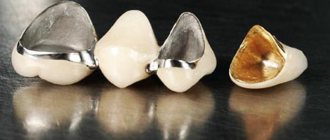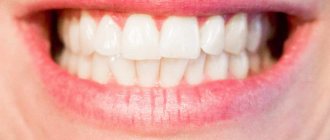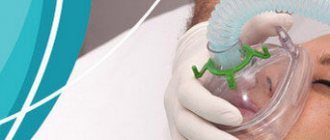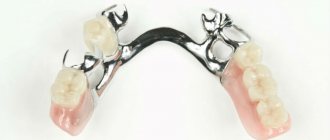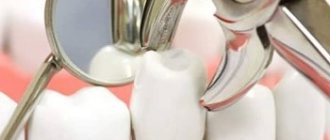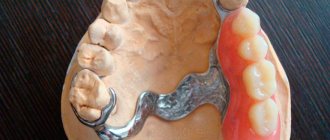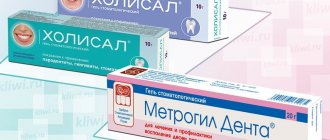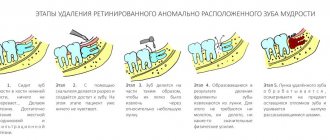Many people have heard that it is possible to perform dental treatment under general anesthesia. This practice is especially often used in pediatric dentistry, when it is necessary to carry out a large amount of dental work, and the child does not communicate well with doctors or is simply afraid. However, sometimes patients confuse the concepts of dental treatment under sedation and treatment under anesthesia - these are two completely different methods.
What is sedation dental treatment?
Sedation is a method of pain relief based on immersing the patient in a relaxed “drowsy” state by inhaling a nitrogen-oxygen mixture or intravenous administration of sedatives. There are two types of such anesthesia: deep sedation, when the patient is in a state of deep sleep and does not respond to external stimuli, and superficial, in which the patient is half asleep, completely retains breathing and is able to hear and follow the doctor’s instructions. In dentistry, dental treatment with superficial sedation is usually used. This method allows you to eliminate discomfort from dental procedures, relieve fear and ensure the absence of stress.
At the same time, the need to carry out conventional local anesthesia remains, since the patient remains able to feel pain. Therefore, the technique involves putting the patient into a state of half-asleep followed by anesthesia - this ensures complete comfort and painlessness of therapeutic procedures.
Who is indicated for general anesthesia during the treatment and extraction of teeth?
There are several categories of patients for whom the use of general anesthesia seems most preferable:
- Patients with an uncontrolled gag reflex. An acute gag reflex can make dental intervention almost impossible, so the use of anesthesia can save the situation.
- Patients with allergies to components of local anesthetic drugs. Unlike local anesthetics, general anesthesia does not cause allergy symptoms (choking, anaphylactic shock), so it is successfully used for the treatment and removal of teeth in allergy sufferers.
- Patients experiencing severe fear of dental surgery. This happens to those who were once patients in Soviet clinics, where pain relief was used extremely rarely - they had to endure pain during any procedure. Fear also haunts those who have not had their teeth treated before. In both cases, anesthesia helps to successfully solve the problem and carry out the necessary treatment.
- Patients with time pressure. A very busy person does not have the opportunity to visit the dentist several times, and general anesthesia makes it possible to carry out the necessary treatment and tooth extraction in one session.
- Children who, due to age, cannot tolerate general treatment.
Indications and contraindications
Indications for dental treatment under sedation are:
- Patient's fear of dental procedures.
- Childhood. Dental treatment under sedation is especially often used in pediatric dentistry, since it is much more difficult for a child to spend 50-60 minutes or more calmly in the dental chair.
- The need for complex therapy of many teeth at once or complex removal.
- Serious discomfort during any dental procedures.
- Hypertension – so that stress during therapeutic procedures does not cause an increase in blood pressure.
Contraindications include alcohol or drug intoxication, pregnancy, certain types of mental disorders, the presence of traumatic brain injuries, and age less than three years. Also a contraindication is the patient’s individual allergic reaction to local anesthetics.
When deletion is indicated
There are indications for which wisdom teeth are always removed. These include:
- Too dense arrangement of teeth is the so-called crowding of teeth. This leads to difficulties with the eruption of the wisdom tooth, as a result of which it grows crookedly and causes serious pain. When teeth are impacted, infectious and inflammatory processes in the oral cavity are often observed. These problems can only be solved by removing pathologically located wisdom teeth.
- When there is a malocclusion or crooked teeth, orthodontists most often prescribe the installation of braces. The process of wisdom teeth erupting displaces the entire dentition, and this can cause pain when wearing braces. To avoid this problem, wisdom teeth are removed in advance, even if the process of eruption has not yet begun.
- Dental diseases of the wisdom tooth (pulpitis, periodontitis, caries) become a common reason for its removal. Therapeutic methods for treating such a tooth are associated with serious difficulties, and the tooth itself does not provide any useful function. Therefore, you can get rid of a diseased wisdom tooth without regrets.
The wisdom teeth removal procedure can be performed under local or general anesthesia. Indications for the use of general anesthesia include:
- inadequate psychological state of the patient, panic;
- More than one tooth needs to be removed;
- gag reflex during dental procedures;
- allergy to local anesthesia.
To avoid an allergic reaction to general anesthesia, a full examination of the patient is carried out, the drug and dose are selected individually.
Removing wisdom teeth under general anesthesia has many contraindications. For example, general anesthesia cannot be used if the following pathologies are present:
- hormone-dependent diseases;
- acute neurotic and psychiatric diseases (epilepsy and others);
- various types of heart rhythm disturbances: slow cardiac activity, attacks of tachycardia with a heart rate of more than 140 beats per minute, atrial fibrillation with a rate of over 100 beats per minute;
- the presence of problems with blood circulation in the brain that began 6 months ago;
- myocardial infarction that occurred less than six months before surgery;
- unstable angina or stable, severe exertional angina;
- when the patient's diastolic blood pressure is above 110 mm Hg;
- uncompensated heart failure with pronounced swelling in the legs, weakness and severe shortness of breath;
- severe stenosis of the mitral or aortic heart valve;
- severe bronchial asthma;
- acute diseases of the respiratory system, accompanied by fever or cough;
- pneumonia;
- exacerbation of chronic bronchitis or acute bronchitis;
- drug or alcohol intoxication;
- tuberculosis, pneumonia, ARVI, exacerbation of bronchial asthma;
- diseases of the cardiovascular system, accompanied by damage to the heart muscle, circulatory disorders and sclerotic changes in blood vessels;
- impaired renal and liver function;
- hyperthyroidism, diabetes mellitus, adrenal insufficiency.
Pregnant women, as well as persons who have been vaccinated no earlier than two weeks before surgery, are also contraindicated in general anesthesia.
How dental treatment is performed under sedation in children and adults, reviews
In pediatric dentistry with sedation, a nitrogen-oxygen mixture (70% nitrogen, 30% oxygen) is most often used, which the child inhales through a special mask. Adults are usually offered intravenous administration of a sedative, but the “mask” method can also be used if desired.
The sedative effect occurs within 4-5 minutes. The procedure itself is completely safe, including for small patients - it does not give any euphoric or consciousness-suppressing effect, it only produces a calming and relaxing effect. This way, the person becomes more tolerant of the treatment and can sit calmly in the dental chair longer. In this case, the doctor is in complete control of the situation, because he can freely communicate with the patient.
Dental treatment under sedation, according to patient reviews, is a fairly comfortable procedure that allows not only to effectively eliminate nervousness when visiting a dentist, but also to reduce the number of such visits, since more work can be completed in one visit.
Pros and cons of tooth extraction under anesthesia
Modern dental anesthesia is of two types: intravenous anesthesia and inhalation anesthesia. Inhalation anesthesia means that the patient is put into a state of anesthesia using gaseous drugs supplied through a mask. It is considered safe, but in any case its duration should not exceed one and a half hours.
The service of treatment and removal of teeth under general anesthesia is now available in any clinic, so it is worth considering the pros and cons of using general anesthesia in dentistry. Let's start with the pros:
- Saving time . Under anesthesia, you can perform not only tooth extraction, but also treatment, prosthetics, repair of fillings - and all in one session.
- No pain or fear . Local anesthesia does not always work 100%, and patients experience discomfort during treatment. And local anesthesia certainly does not relieve the fear of treatment and tooth extraction; only anesthesia can cope with this.
- Reducing the risk of inflammation . The use of general anesthesia for treatment and tooth extraction helps reduce the risk of developing alveolitis.
- The best quality of hardening of filling materials . When a dentist performs treatment or extraction of teeth under general anesthesia, he may use drugs that block salivation, which improves the quality of hardening of the filling material. This means that the fillings will hold better.
Now let’s look at the disadvantages of treatment and tooth extraction under anesthesia:
- Risk of negative effects on the body . Of course, in modern clinics the risk of negative effects of anesthesia on the body is minimal, but it exists. Those who have ever received general anesthesia are familiar with the state of recovery from anesthesia: nausea, dizziness, nervous agitation. And this is for a healthy person, but for those who have bronchial asthma or suffer from shortness of breath, have had a heart attack, or are simply elderly, anesthesia is contraindicated.
- Time limit . The flip side of this advantage is its disadvantage: diseases such as pulpitis or complicated caries are best treated gradually, over several visits. If anesthesia is used, the doctor is obliged to solve the problem in one visit: perform pulp removal, root canal filling, select photopolymers for the filling and check the bite. Due to lack of time and lack of feedback from the patient, the dentist may make a mistake. The most common occurrence in such cases is underfilling of the root canals, which leads to complications and even tooth extraction.
For the reasons described above, teeth should be treated and removed under general anesthesia only when necessary and by an experienced dentist.
How is the operation performed?
Before removal, the dentist examines the patient’s oral cavity and takes an x-ray. After diagnosis, he selects a surgical procedure and explains to the patient why it is necessary to remove the wisdom tooth. Removal can be simple or complex. The second operation is more difficult, as the gums and bones are affected.
Easy removal
It is carried out in the same way as on ordinary teeth. Suitable for removal of the upper eights if there are no serious developmental abnormalities or complications. The dental unit is removed with forceps, without the use of other instruments. The operation is low-traumatic and takes from 10 to 30 minutes.
Step-by-step removal of the 8th tooth:
- anesthesia;
- extraction from the hole;
- removal of fragments if the tooth is crumbled;
- treating the wound with an anesthetic.
After the operation, the doctor gives the patient recommendations for oral care over the next few days. If necessary, prescribes medications for pain and to prevent wound infection.
Difficult removal
It is carried out on the lower molars or on the upper ones, if the coronal part is practically destroyed, there are pathologies in the roots, in case of developmental anomalies, complications. The surgeon can use a scalpel, drill and other surgical instruments. Before the procedure, the patient must tell the doctor about the presence of diseases or allergies to medications to exclude contraindications. How long it takes to remove a wisdom tooth depends on the clinical picture. The duration of surgical procedures is from half an hour to two hours.
Operation stages:
- pain relief with local anesthetics;
- antiseptic surface treatment;
- cutting and detachment of a flap of gingival tissue;
- drilling the bone, extracting a dental unit;
- treatment of the wound with drugs;
- suturing.
After the procedure, the surgeon advises the patient about precautions during the postoperative period and prescribes antibacterial and painkillers. It is necessary to visit the doctor again to examine the wound.
Types of sedation
When removing teeth, different types of drug sedation are used. Thus, the highest level clinics offer patients propofol, a short-acting sedative, as well as combinations based on it. Budgetary institutions do not have such an opportunity. Barbiturates are often used here, as well as nitrous oxide or drugs belonging to the benzodiazepine series.
The routes of administration of medications are also different: intramuscular, intravenous, in addition, oral, inhalation or combined. The best option for tooth extraction under sedation in Moscow and the price can only be determined by an anesthesiologist after assessing the patient’s current health condition and its characteristics.
Anesthesia – benefit or harm?
The possibilities of modern medicine are incredibly great. Our clinic uses very high-quality drugs that can relieve the patient from painful sensations during surgical procedures, and at the same time are completely safe for health. Already 30-40 minutes after the end of the manipulations, the person can go home. Nowadays, you don’t have to endure severe pain during dental procedures. Qualified doctors know how to create maximum comfort for each patient. We have done everything to ensure that if it is necessary to remove a tooth, there will be no fear or worry. For patients who needed tooth extraction, the price in Dolgoprudny will be another reassuring factor. This or that type of anesthesia is immediately included in the price.
What drugs do we use?
- Sevoran
(Great Britain). An inhalational anesthetic that provides rapid induction of anesthesia. We have been using this drug in anesthesia treatment for more than 15 years - in adults and children.
- Supran
(Baxter company, USA). Anesthesia with this drug is available in our clinics on Prospekt Mira and Novye Cheryomushki. Studies show that Supran is eliminated from the body faster, which means that patients recover more quickly after waking up - full activity within 1 hour after completion of treatment. This drug is especially relevant for long-term anesthesia - 3 hours or longer. You will decide which anesthesia drug is ideal in your case together with your anesthesiologist during your consultation.
Is it painful to have wisdom teeth removed?
This procedure is completely painless as it is performed under general anesthesia. But even if local anesthesia is chosen, the patient does not experience pain, but some discomfort may be observed. This type of anesthesia is indicated for those patients who are terrified of having their wisdom teeth removed, in particularly difficult cases and when several teeth need to be removed at once.
Minor pain may occur after wisdom tooth removal, when the anesthesia wears off. To relieve pain, the doctor prescribes analgesics.
What is particularly difficult about wisdom teeth removal?
The problem is retention and dystopia !
Impacted teeth are called partially or completely unerupted teeth due to various reasons, most often the eighth teeth.
Dystopic teeth are teeth that grow incorrectly: tilted or rotated around their axis, displaced forward, backward or to the side.
If removal is necessary, the doctor is forced to practically “cut them out” from the thickness of the bone, which requires enormous skill and experience in surgical dentistry or even in maxillofacial surgery! The duration, special complexity of this operation and pain are for many patients a direct indication for general anesthesia (anesthesia) for this type of intervention.

